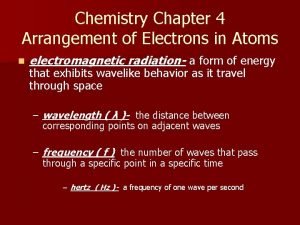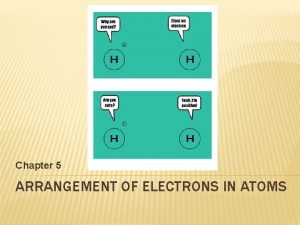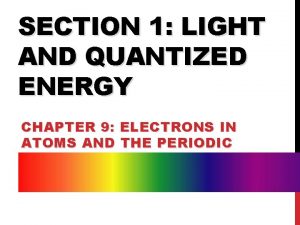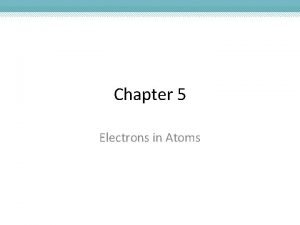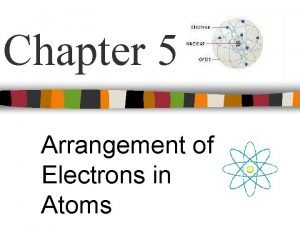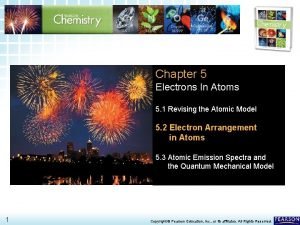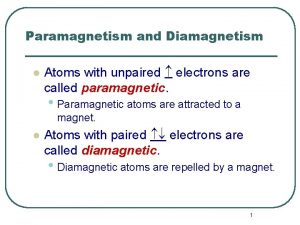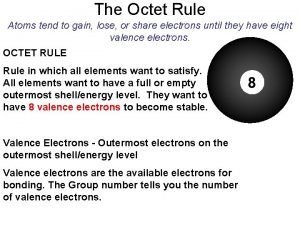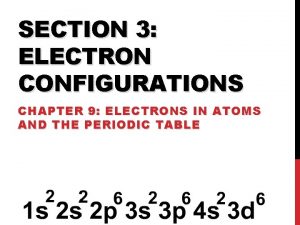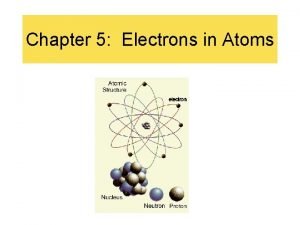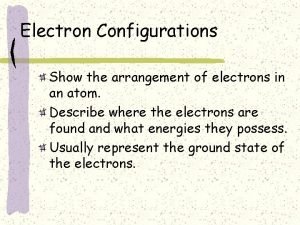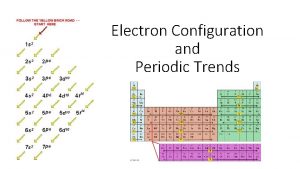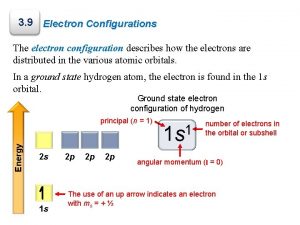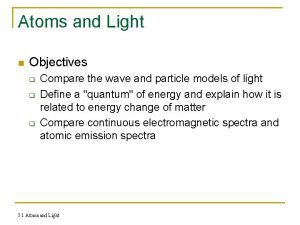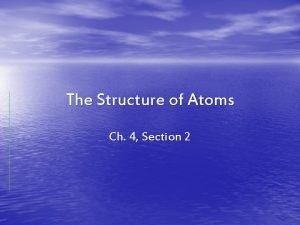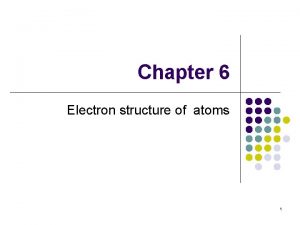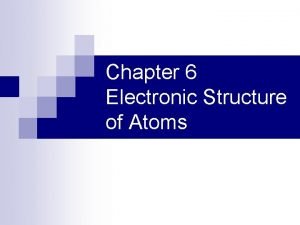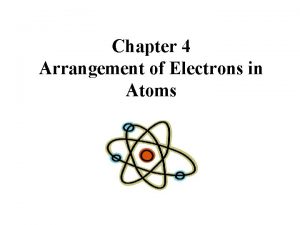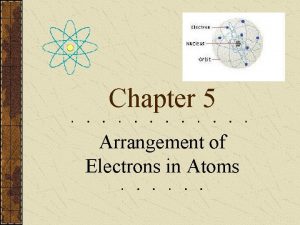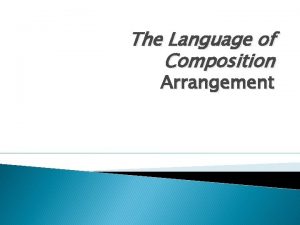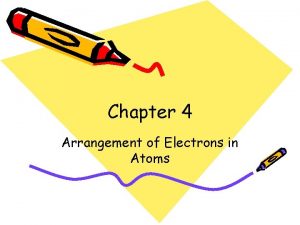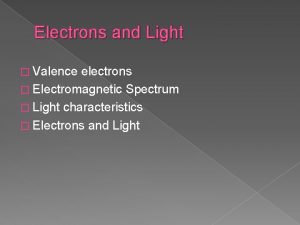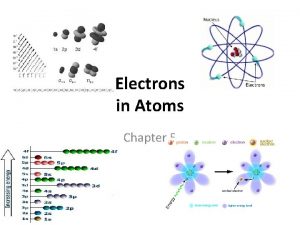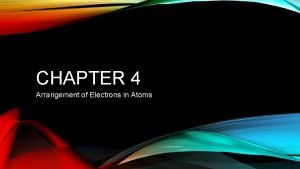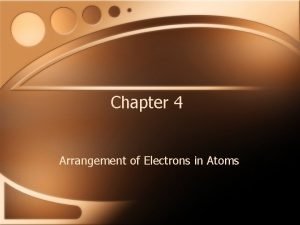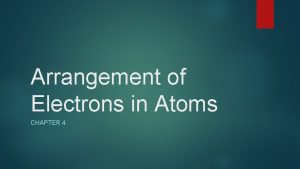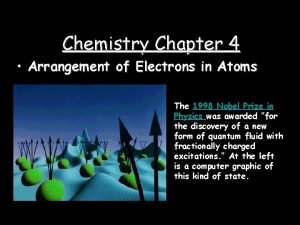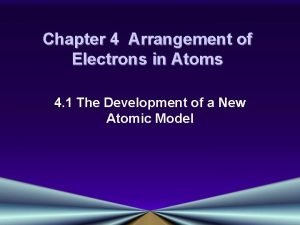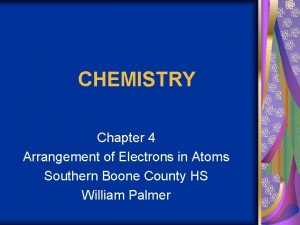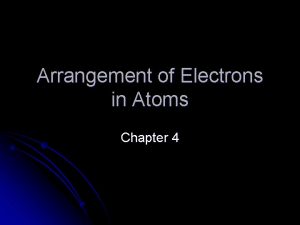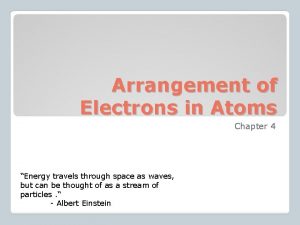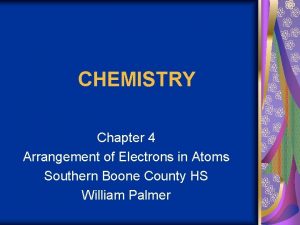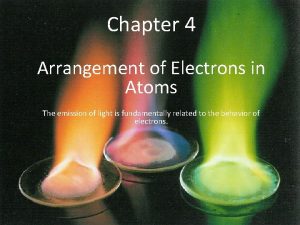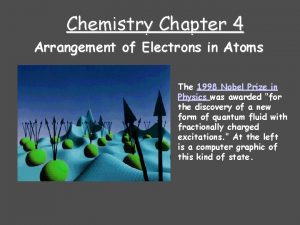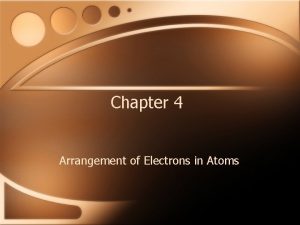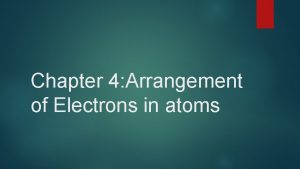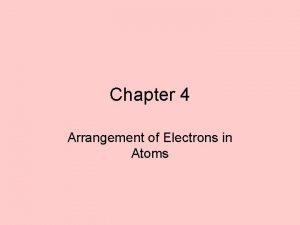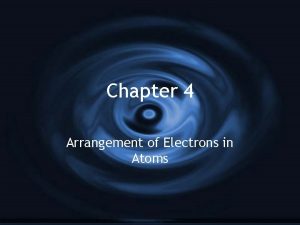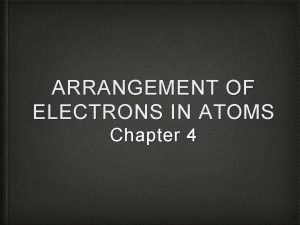Chapter 5 Arrangement of Electrons in Atoms Light
































- Slides: 32

Chapter 5 Arrangement of Electrons in Atoms

Light Dual Nature of Light: Light can act like waves, and as straight line particles. Light is one type of _______which is a form of Energy that has wavelike behavior Other types of em radiation are: x-rays, uv, infrared, microwaves & radio, and together they all form the _______________ (look at p. 92 Figure 4 -1 on next slide)


The Wave The speed of all em waves through a vacuum (space) and through air is: ________________ The length of each individual wave is known as it’s _________ ( ) which is the length between corresponding points on adjacent waves, usually measured in ______ (1 nm = 10 -9 m) The _______ (f or ) is how many waves pass a particular point in a second and is measured in waves/second = _____ (Hz)

The relationship between them is as follows: c=fx E. g. What is the wavelength & color of light that has a frequency of 6 x 1014 Hz (1/s)? f= c= = c=fx

If em radiation is directed towards a piece of metal, it may have enough energy to knock out electrons. This is known as the ____________. A German physicist: Max Planck, explained the reason why, but first let’s look at what he discovered.

When an object gets hot, it emits energy in small specific amounts called quanta. A quantum is the minimum amount of energy that can be lost or gained by an atom. The frequency determines the Energy by: ____ Where Planck’s constant = h = _______ E. g. What is the Energy of Green light with a frequency of 6 x 1014 Hz ? f= E = h. f

It was Einstein that proposed that light acted like a stream of particles called photons. A ______ is a particle of em radiation that has zero mass and carrying a _______ of energy There must be a minimum amount of energy to eject electrons from a metal _____, Planck realized that the em radiation providing the energy, must be of a certain frequency. Different metals need different minimum amounts of energy, and therefore frequencies

The Hydrogen Atom Consider the H atom with its one electron spinning around its one proton. When the electron is closest to the proton/nucleus which is at its lowest energy state, the atom is in its ground state. When energy, like heat, is supplied to the atom, the electron jumps to a higher orbit which is at a higher energy state. The atom is now in an excited state.

When the electron ______________________ __or a lower energy state, it emits a photon of radiation with a specific amount of energy, and not continuous amounts of energy. Therefore, specific _______ of light are emitted when excited Hydrogen “cools” down.

Bohr Model Niels Bohr (Danish) proposed a model that stated: “the e- of a H atom can circle the nucleus in allowed paths called _____” Between the orbit and the nucleus, is a large empty space where the e______ exist

When the ____ atom gets excited, the e- jumps to another specific orbit and not somewhere in between – like going up a ladder When the e- falls back, it ______ in the form of a photon (a bundle of light energy) Convert circular orbits to lines

The amount of Energy is _______ to the difference in the two _____ (orbit) levels So there are specific frequencies (colors of light) given off when the H e- ______ from the higher orbits giving its visible line spectrum

Quantum Model of Atom Question is: Why can’t e-’s be in an orbit between the ____ Energy levels? French scientist Louis De. Broglie pointed out that the electron orbits acted like the behavior of waves. i. e. you can only have a certain amount of waves in a given _________ – not ½ of a wave If you can only have specific # of waves, then based on the formula _______ you can only have specific f’s, which in turn translates into specific Energy levels.

Heisenberg Uncertainty Principle States that: “it is impossible to determine _______ the position and velocity of an electron or any other particle” This is because whatever you use to observe subatomic particles, will affect the particles themselves. i. e you can’t observe/measure without disturbing it.

Quantum Numbers __________(n) indicates the main energy level (or shell) occupied by the electron. Principle ___________ is also referred to as the Principle Energy Level (n). n = 1, 2, 3, 4… where n = 1 is the closest to the nucleus. (Diagram: H atom Circular orbits to linear 1, 2, 3, …)

The electron now has an _____ number of Energy levels (shells) to jump to depending on the Energy input.

Each Energy level (n) divides up further into sublevels/subshells. How many divisions depends on the original Energy level. The 1 st E level has 1 sublevel (s only) 2 nd 2 sublevels (s and p) 3 rd 3 sublevels (s, p, and d) 4 th 4 sublevels (s, p, d and f) : : i. e nth n sublevels.

s-Orbital Each sublevel is assigned an _________ ( l ) and has a particular shape. The first sublevel in each E level has a spherical shape. (assigned the letter s). There is only 1 possible orientation. (aka orbital) The shape is determined by the electron’s path over time.

p- Orbital The ________in each E level has a figure eight shape. (assigned the letter p ). There are 3 possible orientations (orbitals)

d- orbital The _______in each E level is designated an has a four leaf clover shape. (assigned the letter d ). There are 5 possible orientations (orbitals)


f, g and h are indescribable! The ________in each E level has an indescribable shape. (assigned the letter ___ ). There are 7 possible orientations (orbitals) The _________in each E level has an indescribable shape. (assigned the letter ___ ). There are 9 possible orientations (orbitals). The ________in each E level has an indescribable shape. (assigned the letter ____ ). There are 11 possible orientations (orbitals). Summary on board

To sum up: . . Principle E level # sublevels (n). 1 1 1 s 2 2 2 s 2 p 3 3 3 s 3 p 3 d 4 4 4 s 4 p 4 d 4 f 5 5 5 s 5 p 5 d 5 f 5 g 6 6 6 s 6 p 6 d 6 f 6 g 6 h We expect the order of the orbitals to increase as follows: 1 s 2 s 2 p 3 s 3 p 3 d 4 s 4 p 4 d 4 f 5 s 5 p 5 d 5 f 5 g 6 s 6 p …

But in reality, from Energy level 3, there are some overlaps. There is an easy way to determine the actual order. ( demonstrate diagonal method) So, the actual order is as follows: 1 s 2 s 2 p 3 s 3 p 4 s 3 d 4 p 5 s 4 d 5 p 6 s 4 f 5 d 6 p 7 s 5 f 6 d 7 p 8 s

Now each _______ (orientation) can hold 2 ____. The s sublevel which has 1 orbital can hold 2 e- ’s p 3 6 d 5 10 f 7 14 g 9 18 h 11 22.

So now, the BIG picture is as follows: . Principle E level (n) 1 2 3 4 5 6 # sublevels (n) 1 2 3 4 5 6 # of each type of orbital spdfgh 1 13 13579 1 3 5 7 9 11 Total # of orbitals (n 2) 1 4 9 16 25 36 . Total # of e- ‘s (2 n 2 )

Electron Configuration Each orbital (orientation) can hold _____and can be represented by a box, circle or underline. (diagram) (complete orbital chart) For each electron, they orbit with a spin around in 2 different ways – ____________. One type of spin produces a magnetic field with a North up (_____), and the other produces a North down (_____) (diagram) The electrons are represented by _______ pointing up or down, depending on their spin. (diagram)

According to the: Pauli Exclusion principle, in order for 2 electrons to occupy the same orbital, they must have opposite spins. e. g. Hydrogen has 1 e- that occupies the lowest Energy level – 1 s. 1 s Helium has 2 e-’s that also occupies the lowest Energy level – 1 s. Opposing arrows that represent opposite spins. 1 s

Rules of Procedure for Electron Configuration: 1. ______: an electron occupies the lowest 2. 3. energy orbital that can receive it. (i. e. start from the bottom) __________: no 2 electrons in the same atom can have the same set of 4 quantum numbers. (i. e. no more than 2 electrons per orbital) ________: orbitals of equal energy are each occupied by one electron before any orbital is occupied by a 2 nd electron, and all electrons in singly occupied orbitals must have the same spin. (i. e. don’t double up until each orbital has an up arrow)

Now do Oxygen & explain:

____________: the way electrons are arranged amongst the orbitals. A special notation is used which consists of: the principle E level, the sublevel & the # of electrons in that sublevel. e. g. the 1 electron in Hydrogen occupies the 1 st orbital, in the 1 st sublevel, in the 1 st E level. (diagram) e. g. the 2 electrons in Helium also occupy the 1 st orbital, in the 1 st sublevel, in the 1 st E level. (diagram) e. g. for Lithium, which has 3 electrons, it’s as follows: (diagram)
 Chapter 4 arrangement of electrons in atoms test
Chapter 4 arrangement of electrons in atoms test Chapter 5 arrangement of electrons
Chapter 5 arrangement of electrons Electrons in atoms section 1 light and quantized energy
Electrons in atoms section 1 light and quantized energy Electrons in atoms section 1 light and quantized energy
Electrons in atoms section 1 light and quantized energy Chapter 5 electrons in atoms
Chapter 5 electrons in atoms Light light light chapter 23
Light light light chapter 23 Light light light chapter 22
Light light light chapter 22 Chapter 22
Chapter 22 Chapter 5 arrangement of electrons
Chapter 5 arrangement of electrons Chapter 5 arrangement of electrons
Chapter 5 arrangement of electrons Regents periodic table
Regents periodic table Atoms with 4 valence electrons
Atoms with 4 valence electrons Atoms with unpaired electrons are called diamagnetic.
Atoms with unpaired electrons are called diamagnetic. Label an atom
Label an atom The lowest allowable energy state of an atom is called
The lowest allowable energy state of an atom is called Electrons in atoms section 2 quantum theory and the atom
Electrons in atoms section 2 quantum theory and the atom Aluminum chloride charge
Aluminum chloride charge How do chemists model the valence electrons of metal atoms?
How do chemists model the valence electrons of metal atoms? Metallic bond formula
Metallic bond formula Electrons configurations
Electrons configurations 5 electrons in atoms
5 electrons in atoms Unstable arrangement of atoms
Unstable arrangement of atoms Electronic configuration is arrangement of electrons in
Electronic configuration is arrangement of electrons in Hund's rule vs pauli exclusion principle
Hund's rule vs pauli exclusion principle What are electron configurations
What are electron configurations Electrons and light pogil activity 5-1
Electrons and light pogil activity 5-1 The arrangement of opposite elements (ex. light vs. dark)
The arrangement of opposite elements (ex. light vs. dark) Chapter 4 section 2 the structure of atoms answer key
Chapter 4 section 2 the structure of atoms answer key Chemistry in biology section 2 chemical reactions
Chemistry in biology section 2 chemical reactions Chapter 6 electronic structure of atoms answers
Chapter 6 electronic structure of atoms answers Chapter 6 section 1 atoms elements and compounds
Chapter 6 section 1 atoms elements and compounds Electronic structure of atoms
Electronic structure of atoms Chapter 3 atoms the building blocks of matter
Chapter 3 atoms the building blocks of matter
